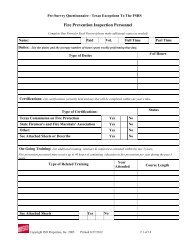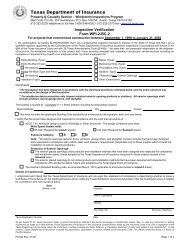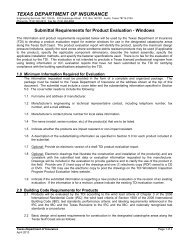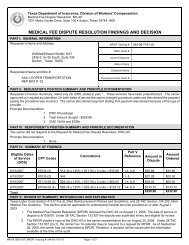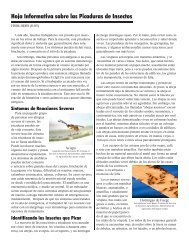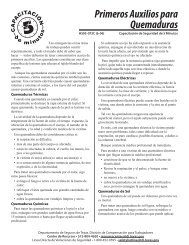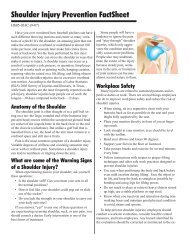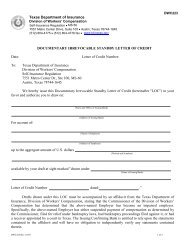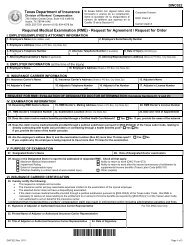Lockout Tagout - Texas Department of Insurance
Lockout Tagout - Texas Department of Insurance
Lockout Tagout - Texas Department of Insurance
You also want an ePaper? Increase the reach of your titles
YUMPU automatically turns print PDFs into web optimized ePapers that Google loves.
energy isolating device or permanently alter its energy<br />
control capability.<br />
Energized - connected to an energy source or containing<br />
residual or stored energy.<br />
Energy Isolating Device - a mechanical device that<br />
physically prevents the transmission or release <strong>of</strong> energy<br />
including but not limited to the following: A manually<br />
operated electrical circuit breaker; a disconnect switch;<br />
a manually operated switch by which the conductors <strong>of</strong> a<br />
circuit can be disconnected from all ungrounded supply<br />
conductors and, in addition, no pole can be operated<br />
independently; a slide gate; a slip blind; a line valve; a<br />
block; and any similar device used to block or isolate<br />
energy. The term does not include a push buttons, selector<br />
switches, and other control circuit type devices.<br />
Energy Source - any source <strong>of</strong> kinetic or potential<br />
energy, including but not limited to electrical, mechanical,<br />
hydraulic, pneumatic, chemical, and/or thermal<br />
energy.<br />
Hot Tap - a procedure used in the repair, maintenance<br />
and services activities which involves welding on a piece<br />
<strong>of</strong> equipment (pipelines, vessels or tanks) under pressure,<br />
in order to install connections or appurtenances. It is<br />
commonly used to replace or add sections <strong>of</strong> pipeline<br />
without the interruption <strong>of</strong> service for air, gas, water,<br />
steam, and petrochemical distribution systems.<br />
<strong>Lockout</strong> - the placement <strong>of</strong> a lockout device on an energy<br />
isolating device, in accordance with an established<br />
procedure, ensuring that the energy isolating device and<br />
the equipment being controlled cannot be operated until<br />
the lockout device is removed.<br />
<strong>Lockout</strong> Device - a device that utilizes a positive means<br />
such as a lock, either key or combination type, to hold an<br />
energy isolating device in the safe position and to prevent<br />
the energizing <strong>of</strong> a machine or equipment.<br />
Normal Production Operation - the utilization <strong>of</strong> a<br />
machine or equipment to perform its intended production<br />
function.<br />
Servicing and/or Maintenance - workplace activities<br />
such as constructing, installing, setting up, adjusting,<br />
inspecting, modifying, and maintaining and/or servicing<br />
machines or equipment. These activities include<br />
lubrication, cleaning or un-jamming <strong>of</strong> machines or<br />
equipment and making adjustments or tool changes,<br />
where the employee may be exposed to the unexpected<br />
2<br />
energization or start-up <strong>of</strong> the equipment or release <strong>of</strong><br />
hazardous energy.<br />
Setting Up - Any work performed to prepare a machine or<br />
equipment to perform its normal production operation.<br />
<strong>Tagout</strong> - the placement <strong>of</strong> a tagout device on an energyisolating<br />
device, in accordance with an established<br />
procedure, to indicate that the energy isolating device<br />
and the equipment being controlled may not be operated<br />
until the tagout device is removed.<br />
<strong>Tagout</strong> Device - a prominent warning device, such as a<br />
tag and a means <strong>of</strong> attachment, which can be securely<br />
fastened to an energy isolating device in accordance<br />
with an established procedure, to indicate that the energy<br />
isolating device and the equipment being controlled may<br />
not be operated until the tagout device is removed.<br />
Responsibility<br />
Employers are responsible for the establishment <strong>of</strong> a<br />
LOTO program, maintaining the lockout/tagout activity<br />
log, employee training, and periodic inspections. The<br />
lockout/tagout activity log is a document that is used<br />
to record each time that a lockout/tagout procedure is<br />
utilized. In smaller facilities, one centrally-located log<br />
is acceptable and the maintenance supervisor usually<br />
maintains it. In larger facilities, it is advisable for each<br />
department or work group to maintain area-specific logs<br />
that will be collected annually and stored in a central<br />
archive. In this case, the area supervisors maintain the<br />
lockout/tagout activity log for their area and either<br />
the maintenance supervisor or the safety manager is<br />
responsible for maintaining the lockout/tagout activity<br />
log central archive. The inspections monitor the<br />
effectiveness <strong>of</strong> the established program and verify that<br />
program revisions have occurred that reflect changes<br />
in process and/or the addition <strong>of</strong> new equipment and<br />
machinery. It is common practice for the employer to



